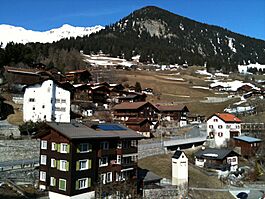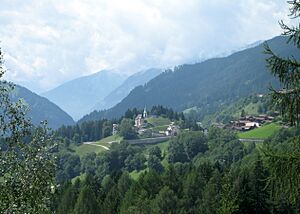Castiel, Switzerland facts for kids
Quick facts for kids
Castiel
|
||
|---|---|---|

Castiel village
|
||
|
||
| Country | Switzerland | |
| Canton | Graubünden | |
| District | Plessur | |
| Area | ||
| • Total | 5.41 km2 (2.09 sq mi) | |
| Elevation | 1,174 m (3,852 ft) | |
| Population
(2010)
|
||
| • Total | 128 | |
| • Density | 23.66/km2 (61.28/sq mi) | |
| Postal code |
7027
|
|
| Surrounded by | Calfreisen, Lüen, St. Peter-Pagig, Praden, Says, Trimmis | |
Castiel was a small town, also known as a municipality, in the Graubünden area of Switzerland. It was located in the Plessur district.
On January 1, 2013, Castiel joined with several other nearby towns. These included Calfreisen, Langwies, Lüen, Molinis, Peist, and St. Peter-Pagig. All these towns became part of the larger municipality of Arosa.
Contents
History of Castiel
Castiel was first mentioned in written records in the year 1132. At that time, it was known by the name Castellum.
Where is Castiel?
Before it joined with Arosa, Castiel covered an area of about 5.4 square kilometers (2.1 square miles). A large part of this land, about 43%, was used for farming. Nearly half of the area, about 49%, was covered by forests.
A small part of the land, less than 2%, had buildings or roads. The rest of the area, about 6%, was made up of natural features like rivers or mountains.
Castiel was located in a valley called Schanfigg. It sat on the northern side of this valley. The town itself had two main parts: Oberdorf and Unterdorf.
Close by, in the town of Lüen, there is a train station called Lüen-Castiel. This station is on the Chur-Arosa railway line, which connects towns in the region.
People and Life in Castiel
In 2010, Castiel had a population of 128 people. A small number of these residents, about 6.5% in 2008, were from other countries. Over the ten years before 2010, the number of people living in Castiel went down slightly.
Most people in Castiel speak German, which is about 97.5% of the population. A smaller group, about 2.5%, speaks Romansh.
The people in Switzerland are generally well-educated. In Castiel, about 70% of adults aged 25 to 64 had finished high school or gone on to higher education. This could be a university or a specialized college.
Castiel had a very low unemployment rate, meaning almost everyone who wanted a job had one. In 2005, there were 20 people working in farming. There were also a few businesses in manufacturing and services.
How Castiel's Population Changed Over Time
The table below shows how the number of people living in Castiel changed over many years:
| year | population |
|---|---|
| 1808 | 54 |
| 1850 | 72 |
| 1880 | 126 |
| 1900 | 90 |
| 1950 | 92 |
| 1960 | 82 |
| 1970 | 94 |
| 1980 | 83 |
| 1990 | 109 |
| 2000 | 119 |
| 2008 | 124 |
| 2010 | 128 |
Important Historical Sites
One very important historical place in Castiel is called Carschlingg. This site is an ancient settlement that was used by people in prehistoric times, during the late Roman period, and in the Early Middle Ages. It is considered a heritage site of national significance in Switzerland. This means it's a very important place for understanding the country's history.
See also
 In Spanish: Castiel (Grisones) para niños
In Spanish: Castiel (Grisones) para niños





